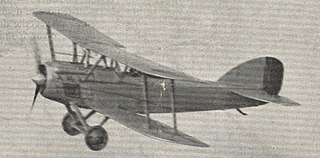Related Research Articles

The AD Flying Boat was designed by the British Admiralty's Air Department to serve as a patrol aircraft that could operate in conjunction with Royal Navy warships. Intended for use during the First World War, production of the aircraft was terminated as the end of the war came into sight, and the type saw little operational use. A number were repurchased after the end of the war by Supermarine Aviation and rebuilt as civil transports, becoming known as the Supermarine Channel.

The Bristol F.2 Fighter is a British First World War two-seat biplane fighter and reconnaissance aircraft developed by Frank Barnwell at the Bristol Aeroplane Company. It is often simply called the Bristol Fighter, "Brisfit" or "Biff".

The Royal Aircraft Factory R.E.8 is a British two-seat biplane reconnaissance and bomber aircraft of the First World War that was designed and produced at the Royal Aircraft Factory. It was also built under contract by Austin Motors, Daimler, Standard Motors, Siddeley-Deasy and the Coventry Ordnance Works.

The Siddeley-Deasy Motor Car Company Limited was a British automobile, aero engine and aircraft company based in Coventry in the early 20th century. It was central to the formation, by merger and buy-out, of the later Armstrong Siddeley Motor and Armstrong Whitworth Aircraft companies.

The Fiat CR.1 was an Italian biplane fighter aircraft of the 1920s. Of wood-and-fabric construction, it was designed by Celestino Rosatelli, from whom it gained the 'CR' designation. Its most distinctive feature was that the lower wings were longer than the upper ones.

The Armstrong Whitworth A.W.14 Starling was a prototype British single-seat biplane fighter developed for the Royal Air Force in the late 1920s which unsuccessfully competed against the Bristol Bulldog.

The Caudron R.4 was a French World War I twin-engine biplane reconnaissance/artillery cooperation aircraft and the progenitor of a series of successful aircraft that filled a variety of roles with the French Aéronautique Militaire.

The Bartel BM 6 was a Polish biplane trainer fighter aircraft of 1930. It did not advance beyond the prototype stage.
The Blériot-SPAD S.81 was a French fighter aircraft developed in 1923 to a requirement by the French Air Force. It was flown competitively against the Dewoitine D.1 and was selected over that aircraft due to the Dewoitine's more radical design, leading to an order for 80 aircraft. The S.81 was a single-bay biplane of conventional configuration with I-shaped interplane struts and lacking Herbemont's usual swept upper wing. It featured a wooden fuselage of monocoque construction and metal wings skinned in fabric. Production versions differed from the prototypes in having a lengthened fuselage and larger tail fin.

The Caudron R.11, was a French three-seat twin-engine long range escort fighter biplane developed and produced by Caudron during the First World War.

The Vickers F.B.26 Vampire was a British single-seat pusher biplane fighter built by Vickers during the First World War.

The Lioré et Olivier LéO H-13 was a French biplane two-engine flying boat of the 1920s, built in passenger and military variants.

The Armstrong Whitworth A.W.19 was a two/three-seat single-engine biplane, built as a general-purpose military aircraft in the mid-1930s. A newer, monoplane aircraft was preferred and only one A.W.19 was built.
The Siddeley-Deasy Sinaia, also known as the Armstrong Whitworth Sinaia was a twin-engined biplane day bomber with gunners in rearwards extensions of the engine nacelles. Two examples were ordered by the Air Ministry but only one was completed.
The Saunders T.1 was the first aircraft built by the Saunders Company, a two-seat single-engined biplane with unusual monocoque fuselage construction. Only one was built.
The Gabardini G.8 was an Italian single-seat aircraft produced in both fighter and trainer versions by Gabardini in 1923.

The Potez X was a French 1920s general-purpose colonial transport aircraft designed and built by Potez.
The Adolphe Bernard AB was a twin-engined French biplane aircraft, built near the end of the First World War. Ten AB 1 BN2 bombers were produced for the Armée de l'Air but did not reach squadron service; post-war, two civil derivatives were considered but only one aircraft was built.

The Blériot-SPAD S.91 was a French light-weight fighter aircraft. It would be later developed into the Blériot-SPAD S.510, the last biplane produced by the French aeronautic industries.

The Astra-Protopopescu or Astra-Proto was a Romanian reconnaissance aircraft flown and tested in 1925.
References
Notes
- 1 2 3 4 5 Tapper 1973 , pp. 110–112, 116
- ↑ Tapper 1973, p. 116
- 1 2 Bruce 1957, pp. 511–512
Bibliography
- Bruce, J.M. (1957). British Aeroplanes 1914–18. London: Putnam.
- Tapper, Oliver (1973). Armstrong Whitworth Aircraft since 1913. London: Putnam Publishing. ISBN 0-370-10004-2.